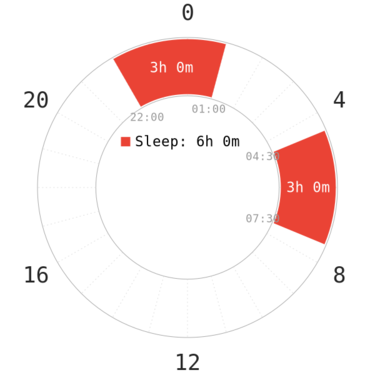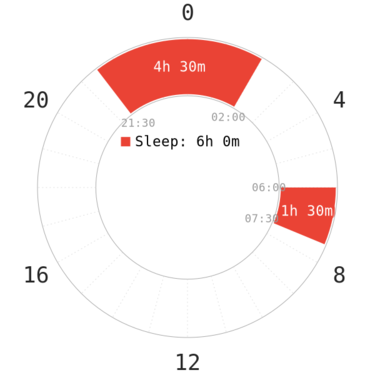Сегментированный
| Сегментированный | |
|---|---|
| ссылка на napchart
Legend
| |
| Время сна | 7 часов |
| Предложено | Нет, используется людьми на протяжении всей истории. |
| Сложность | Умеренная |
| Особенности | 2 длинных ядра ночью, выровненных по пикам SWS и REM соответственно. |
Сегментированный - это бифазный график[1], состоящий из двух ядер ночью, обычно с общим временем сна, близким к личному базовому уровню на монофазном режиме.
Происхождение
Сегментированный сон является одним из исходных полифазных режимов. Это основа линейки расписаний Dual core. Этот режим был широко распространен в обществе до появления электрического освещения. Современные исследования установили, что при сокращенном фотопериоде (более коротком световом дне) без искусственного электрического освещения человеческий сон естественно сегментирован.[2].
Люди часто ложились спать через некоторое время после захода солнца, просыпались через несколько часов, бодрствовали пару часов, а затем снова ложились спать до восхода солнца. Некоторые люди с естественной склонностью к сегментированному сну сообщали, что регулярно просыпались посреди ночи. В подобном случае хорошим выбором будет перейти на сегментированный режим сна.
Механизм
Полифазное сообщество в Discord сделало несколько предположений о механизме сегментированного сна. Данный режим во многом основан на пиках сна. В ранние часы ночи (~21-24), когда начинается естественная секреция мелатонина, можно эффективно получить SWS. Согласно показаниям ЭЭГ адаптированных полифазников, первое ядро обычно насыщено SWS, тогда как второе содержит в основном REM. Таким образом, разделенные ядра более плотно вмещают жизненно важные стадии сна, что позволяет немного сократить общее время сна при стабильном режиме. При подобном графике можно обойтись без дневного нэпа, поскольку довольно длинные ядра ночью сохраняют достаточно легкого сна для поддержания бодрствования днем.
Оба ядра по умолчанию составляют 3,5 часа. Изначально было предположено, что при такой длине что циклы сна расширяются примерно до 105 минут по сравнению с ~90-минутными циклами при монофазном сне. Это также объяснило бы жизнеспособность графика, несмотря на меньшее количество циклов. Однако недавно показания ЭЭГ некоторых участников сообщества показали обратное.
Промежуток бодрствования между двумя ядрами должен составлять не менее 90 минут, при этом часто рекомендуется оставлять более длительный промежуток (~2,5–3 часа). Причина этого в том, чтобы не дать ядрам стать прерванным сном и предотвратить трудности с засыпанием или недостаточной продуктивностью.
Адаптация
Для тех, кто склонен к сегментированному сну, адаптация обычно проста. В обратном случае, она может быть труднее адаптации к Сиесте или E1. Просыпаться после первого ядра и бодрствовать ночью может быть трудным. Со временем при неукоснительном соблюдении графика эти проблемы должны исчезнуть.
После сегментированного можно пойти по пути постепенной адаптации к графикам линейки Dual core, а также Triphasic, поскольку вы приобрели привычку разделения ядер.
Сложность
Уровень сложности сегментированного сна зависит от человека и от общего количества сна на графике. В целом, он считается дружелюбным графиком для новичков.
Variants
While the default dual 3.5 hour core variant has had the most success, a few other combinations are also feasible and have been adapted to in the past. Beginners can attempt these variants, with some precautions.
6-hour total sleep
These are 2 modified variants that have reported some success over the years. Since the total sleep is only 6 hours, it may be suitable for those with slightly below average monophasic baselines (~7h). One problem with this schedule would be a circadian dip in the early afternoon hours, without naps to address them. Because more light sleep has been cut compared to the default variant, staying awake could be more difficult.
The wake gap between each core should be at least 4 hours to cover the SWS and REM peaks more efficiently, as well as to reduce the length of the day gap. The overall adaptation may be more difficult than the standard version because of reduced sleep time. The benefit is the added extra time at night, and only needing to sleep at night without daytime naps.
The difference between 4.5-1.5 and 3-3 core distribution is that those with more SWS requirements can attempt the former option, while those needing similar amounts of REM and SWS can pick the latter. Overall, the 3-3 variant better balances sleep stages, and has seen more success overall than the 4.5-1.5 variant.
Extended/Non-reducing
It is also possible to extend this schedule, possibly to the point that it does not cut any sleep from one's monophasic baseline. This allows for an easy adaptation, while still gaining some of the benefits from Segmented sleep. These schedules may also benefit those with higher sleep needs (~9h on monophasic), younger sleepers, and those who regularly perform intense exercise.
Uneven core lengths
This variant, which is rarely attempted, has cores of slightly different lengths. These variants allows for slightly more time awake, may be easier to schedule, without a significantly harder adaptation. Other plausible combinations include 3-3.5, or even 4.5-2.5 and 5-1.5. It would be helpful to know the SWS and REM requirements before picking any of these variants, though.
Generally, variants with a longer first core allows for more alertness during core gap, and the second core does not need to be as long. However, the longer the first core, the less "DC-like" it becomes, meaning that the sleep stages becomes less distinctly allocated into the two cores. The longer first core may also resemble Siesta, with the second sleep looking like a daytime core sleep.
Late first core
Sleepers who would schedule this variant are expected to have low SWS needs, and/or a lot of polyphasic experience as well as the stringent management of food, exercise and lighting. This variant is not usually recommended, as the first core being away from SWS peak drastically increases the difficulty. Circadian management is recommended, as with other late-core schedules.
For this variant, the core gap can be smaller than the default, because of the higher SWS pressure prior to core 2.
Siesta-hybrid
The idea behind this variant is similar to Siesta, but with both cores at night, and with the short core providing much of the SWS. Sleepers with lower SWS requirements or want to sleep less around evening hours can attempt this variant.
This variant has recorded at least 2 successes; one attempt was in a winter, where photoperiod was short. The first core becomes a lot shorter than usual, being reduced all the way to only 1 cycle, while the second core is much longer to compensate. Similar ideas can apply to 2.5-4.5 core distribution or so.
The main issue with this is that it is impossible for an average sleeper (90m SWS need) to gain all the needed SWS in the first core, the second core will have to provide the remaining SWS, and pushing the second core to late hours of the night may increase the difficulty of the process.
Similar to the default schedule, this variant also takes away some of the social time in the evening in exchange for time in the core gap.
Alternatively, Segmented may be scheduled with one core at night and another core in the day. Only a few successes have been reported thus far. This variant looks like Siesta with a long daytime core, and both core sleeps miss the peaks. The dark period should be 2-3h before the night core, and continue for ~2h after it to stabilize the circadian rhythm.
Adaptations to this would be much more difficult than a regular Segmented schedule, because skipping both sleep peaks can greatly hinder sleep quality. Over the course of adaptation, staying awake during the graveyard and morning hours will be tough, and having a long sleep in the day may disrupt the circadian rhythm.
Night shift
The idea of this is to have both core sleeps after before work. Alternatively, the daytime core can be earlier so that it is shortly after work. Little is known about this scheduling variant, and adaptations have been overall unsuccessful, due to the large circadian rhythm shift it requires.
There have been several failed attempts Segmented sleep for shift work. This is expected, as overall rates of success are very low for shift workers.
Lifestyle Considerations
Segmented, which allows for a range of schedule options, can be suitable for many. It greatly benefits those who naturally wake up during the night, and also allows those who are unable to take a daytime nap to still sleep polyphasically.
Before one transitions to Segmented, it is important to plan what to do during the core gap. Staying awake with few things to do while everyone else is sleeping can be difficult. For naturally segmented sleepers, this is less of a problem. Here are a few tips:
- Make a list of what activities or tasks that are well suited to being done during the night. This includes entertainment! Being alone can also be an advantage at times. Be sure to consider that these hours must be in dark period, in which you will be wearing goggles, and as such will not be able to differentiate colors.
- Dedicate time for self-care. The core gap can be useful for relaxation after long days at work. Self-care can include autogenic training, meditation, yoga, and stretching. Note that it may be unadvisable to do these things when you are having problems staying awake.
- Plan for your day. People often have a lot to work on and care about. No matter how much extra awake time you might have, time management is always important.
Advantages of Segmented over other schedules include:
- Segmented is the only schedule that easily allows >12h of continuous wake time without needing any naps. This can allow many people who are unable to take naps to sleep polyphasically.
- Segmented offers a relatively high amount tst (total sleep time). It is viable to schedule the first core later than normal, ~23, to allow evening events. The only thing to note, though, is that a late first core likely will delay the end of the second core, and may interfere with your morning activities. Under normal scheduling, however, there will be more limited evening social time on Segmented sleep.
- Segmented can become somewhat flexible after adaptation. Some experienced sleepers have reported being able to flex at least one of the core sleeps. Being able to flex the core sleeps allows for more freedom in controlling the length of core gap to suit one's schedule. For example, on days with little to do, the core gap can shrink down a bit, so that the second core can start earlier than usual, or vice versa. When sudden events occur that would require skipping sleep, Segmented also allows relatively fast recovery afterwards.
- Segmented sleep, especially the extended variant with a longer first core, can support intense physical exercise.
- Vivid dreaming experiences have been reported on the schedule over the years, most of which come from the second core.
References
- ↑ polyphasic.net. Retrieved 23-11-2020.
- ↑ https://onlinelibrary.wiley.com/doi/abs/10.1111/j.1365-2869.1992.tb00019.x






